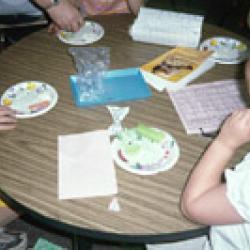Source Institutions
Source Institutions
Add to list Go to activity
Activity link broken? See if it's at the internet archive

This exercise is designed to teach young learners the different parts of a plant (root, stems, leaves, flowers, fruit, and seeds), the basic functions of each part, and to show that tiny microscopic organisms (“germs”) can cause each part of a plant to become diseased. The lesson shows learners the importance of understanding what causes plants to be sick and the need for scientists called plant pathologists to keep plants healthy. In part 1, learners discuss and look at examples of plants (anatomy, function and disease). In part 2, learners taste various parts of plants (i.e. carrot - root, celery - stem). This resource includes discussion questions with answers.
- 10 to 30 minutes
- 30 to 45 minutes
- $5 - $10 per group of students
- Ages 4 - 11
- Activity, Experiment/Lab Activity, Lesson/Lesson Plan
- English
Quick Guide
Materials List (per group of students)
- Edible examples. Choose common and uncommon examples of each plant part as suggested in Table 1.
- Photographs (or live) of the diseased plant parts
- Paper plates
- Napkins
- Bite-sized slice carrots, celery, lettuce, broccoli, cucumbers and popcorn (each in separate containers)
- Salad dressing (Ranch dressing is best received by this age group)
Subjects
-
Life Sciences
-
Diversity of Life
- Plants
-
Human Body
- Health and Nutrition
- Medicine
-
Diversity of Life
-
The Nature of Science
- Science as a Career
Informal Categories
- Food and Cooking
- Gardening
- Nature and Environment
Audience
To use this activity, learners need to:
- see
- taste
Learning styles supported:
- Involves hands-on or lab activities
Other
Components that are part of this resource:
- Purpose and Background Information
- Materials and Methods
- Lesson Plan
- Supplemental Information and References
This resource is part of:
Access Rights:
- Free access
By:
- Elmer, Wade H. ; LaMondia, James A.
Rights:
- All rights reserved, The American Phytopathological Society, 2011
